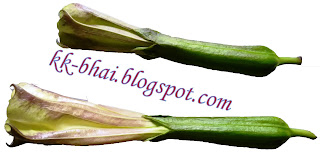Dhatura flower for Lord Shiva
88 views
Skip to first unread message
K.N.RAMESH
Nov 23, 2017, 4:45:07 AM11/23/17
to
courtesy: http://kk-bhai.blogspot.in/2015/05/dhatura-flowers-and-fruits-datura.html
In general when something is offered to gods, it is taken by devotees as "Prasada" after worship. But in the case of Shiva-worship if something is offered to Shiva putting it on the Shiva-linga, the eatables like fruits and sweets are not consumed by devotees as "prasada". So offerings of toxic things like 'bhaang', 'dhatura', 'aak' etc has a symbolic meaning that we should never consume such things and these are to be offered to Shiva only for the grater purpose of welfare of world.
Multi-layered Dhatura
Dhatura flowers and fruits (धतूरा) .. The Datura !
 |
| Blooming Dhatura flowers |
Only God Shiva is offered this flower of Dhatura (धतूरा)!
Dhatura is known by the name of Datura, Angel's trumpet, thorn apple or moon-flower. It is found all over the world in tropical and temperate zone. Its trumpet like look is very attractive. It grows and flowers in the rainy season which contains the Hindu month of "Sawan". "Sawan" is the holy month in which Shiva is specially worshiped. Availability of Dhatura flowers and fruits in this month makes Shiva devotees happy. Both flowers and fruits are offered to Shiva. Though both Dhatura flowers and fruits are toxic, Shiva accepts them because he can tolerate them. As you know He had taken the most toxic poison (विष) named "Halahal" which came out of ocean when it was churned by gods and devils. This story of Hindu mythology says that Shiva took that poison to save the world and kept it in his throat. It made his throat blue. So He is also called "Neel-Kanth" meaning blue throat. Dhaturafruits which have thorns on it contain numerous toxic seeds. These seeds when consumed even in small quantities may produce symptoms of hallucination to madness. A bit more taken may result in death.
 |
| A bunch of double layered Dhatura flowers in the flower basket for worship |
Why God Shiva is offered toxic things like this
In general when something is offered to gods, it is taken by devotees as "Prasada" after worship. But in the case of Shiva-worship if something is offered to Shiva putting it on the Shiva-linga, the eatables like fruits and sweets are not consumed by devotees as "prasada". So offerings of toxic things like 'bhaang', 'dhatura', 'aak' etc has a symbolic meaning that we should never consume such things and these are to be offered to Shiva only for the grater purpose of welfare of world.
In towns the flowers and fruits of Dhatura is in great demand in the month of "Sawana". Poor boys of nearby villages collect them and sell near temples at a good price. So by the grace of Shiva they earn some money.
How can "Dhatura" be identified
Dhatura/Datura has many varieties all over the world. There are some other close relatives of this plant. But the Dhatura used for worship in India is a plant of herb category growing up to a height of about two meters. Flowers are white with blue tint. Generally the they have simple trumpet like structure. But some varieties have double layers of petals as if one trumpet is inserted in other. They flower erect and do not droop or hang. There are some other relatives of this plant which are bigger in size like a shrub and its flowers hang like a bell. But these are bell-flowers, not 'Dhatura'. So not used in worship. The thorny fruit called thorn apple is another thing from which it can be identified.
It flourishes in warm and humid areas and easily can be seen as a healthy plant with big flowers. But it can even grow in water deficient areas changing its look drastically. Small thin plant with smaller flowers. Many times botanists have got confused thinking these two as different varieties. But later they found these as same. It is a hardy plant but can not withstand very cold and frosty weather. It even can not survive in water logged conditioned.
Uses of 'Dhatura"
In India "Dhatura" flowers and fruits are mainly used in worship of Shiva. Sometimes its toxic seeds are used in very small quantities as medicine in 'Ayurveda'. In other parts of world and mostly in tribal community its seeds and roots are used in rituals of ghost calling.
Multi-layered Dhatura 
Triple layered "Dhatura" flower

Today on 16/09/2015 on the occasion of "Teej" festival our worship-flower supplier boy gave a bunch of "Dhatura"flowers, most of which had double layered petals. But a few of them had three layers. Remarkable difference between double layered and triple layered flowers is that while in the double layered flower half of the inner round of petals is protruded outward (as is clear from the picture above) but in the triple layered all the three layers of petals are almost at the same level. It makes triple layered flower bigger and denser. It has more shade of blue over white. I am giving a picture of this multi-layered "Dhatura" flower.
Reply all
Reply to author
Forward
0 new messages


